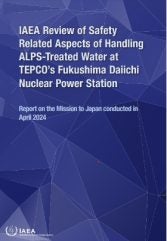
The discharge of treated water from Japan’s Fukushima Daiichi NPP continues to comply with international safety standards, the International Atomic Energy Agency (IAEA) Task Force confirmed in its second report since the water discharge began in August last year. The Task Force, established to review the safety of Japan’s treated water discharge into the sea, also reaffirmed the conclusions from the IAEA’s comprehensive safety report.
IAEA Director General Rafael Mariano Grossi established the Task Force in 2021 to ensure a transparent and inclusive safety review of Japan’s plans for the water discharge. It comprises IAEA and independent experts from 11 different countries and is chaired by a senior IAEA official. The report from the Task Force’s first mission after the discharge was issued in early 2024.
The new 23-page report covers the finding of its mission to Japan from 23 to 26 April, the seventh since it was established in 2021. The Task Force visited the Fukushima site and discussed technical issues with Japan’s Ministry of Economy, Trade & Industry (METI) and plant operator Tokyo Electric Power Company (Tepco) as well as with the Nuclear Regulation Authority (NRA).
The IAEA’s comprehensive report issued in July 2023 before the discharge began the following month found Japan’s plan for handling the treated water to be consistent with international safety standards and that the planned discharge would have a negligible radiological impact to people and the environment.
Contaminated water, used to cool the melted reactor cores in the aftermath of the 2011 nuclear disaster at Fukushima, is stored in around 1,000 huge tanks at the plant containing more than 1.3m tonnes and total storage capacity has been reached. The contaminated cooling water and groundwater is treated by the Advanced Liquid Processing System (ALPS), which removes most of the radioactive contamination, with the exception of tritium. The treated water is then diluted with seawater to one-fortieth of the concentration permitted under Japanese safety standards before being released through an undergound tunnel one kilometre offshore.
Tepco intends to continue discharging the water in batches. The total water discharged so far is approximately 55,000 cubic metres, following completion of the seventh batch on 16 July. IAEA expert analysis of the seven batches released have confirmed the tritium concentration in each batch to date is far below Japan’s operational limit.
During its April mission, the Task Force visited the facilities and equipment installed at the FDNPS to discharge the ALPS (Advanced Liquid Processing System) treated water. This included the measurement tanks holding the water prepared for discharge, the flow control valves, emergency isolation valve and the seawater pumps. The Task Force also reviewed the radiation monitors and flow rate detectors installed throughout the discharge facilities, which provide live data to the IAEA’s real time monitoring page.
Task Force reviewed the status of the IAEA’s independent corroboration of Japan’s source and environmental monitoring programmes, and the onsite sampling and analysis activities conducted by IAEA experts at the plant site. The IAEA is conducting a series of interlaboratory comparisons (ILCs) to corroborate the source and environmental monitoring conducted by Tepco and other relevant Japanese authorities for the ALPS treated water discharge.
The Task Force concluded that the regulatory infrastructure in place is appropriate to provide operational safety oversight of the discharge of ALPS treated water, and was able to witness first-hand the continuous onsite presence of the NRA and their activities in this regard. It confirmed that the equipment and facilities are installed and operated in a manner consistent with Japan’s Implementation Plan for the water discharge and the relevant international safety standards.
The Task Force noted the importance of IAEA’s ongoing corroboration activities and its on-site independent sampling and analyses, in providing a comprehensive, transparent and objective verification of the accuracy and reliability of the data reported by Tepco and the Government of Japan and to help build confidence.
The Task Force encouraged Japan to carefully analyse all monitoring results as they become available to track consistency with projections and to identify any developing trends. Several new and updated information systems are maintained for the purpose of sharing the results of marine environmental monitoring data related to ALPS.
The report noted that the Task Force’s recommendation to develop a collection of all the monitoring data into a single website and to share it in an easily accessible format has been addressed to a certain extent. However, there are now so many information systems available, all containing similar but not identical data and the Task Force believes that there is still a need for a single, clearly identified, onestop-shop for the most up to date monitoring data by the Government of Japan.
While acknowledging that this is not directly required by relevant international safety standards, this important data should be shared as effectively and as widely as possible, not least to promote transparency and to support the involvement of interested parties.
The Task Force will continue to review the activities of Tepco and NRA to assess whether they are consistent with the relevant international safety standards. During the mission the Task Force discussed its next steps and highlighted a desire to continue conducting routine review missions to Japan. The next review mission is anticipated to take place in the last quarter 2024.
In addition to the routine review missions, the Task Force may conduct additional ad hoc missions or technical reviews depending on the operational situation of the discharge of ALPS treated water or if key technical documents were to change significantly. The Agency also maintains its continuous presence at the IAEA Fukushima Daiichi NPP Office, established in July 2023, to monitor and assess the ongoing water discharge.






